Research on the Evolution of Global Electronics Trade Network Structure since the 21st Century from the Chinese Perspective
Abstract
1. Introduction
2. Data Sources and Methodology
2.1. Data Sources
2.2. Research Methodology
2.2.1. E-Products Trade Network Building
2.2.2. Analysis of the Overall Characteristics of the Electronics Trade Network
- (1)
- The network density (D) is a measure of the proportion of existing edges in the network to the maximum number of edges that could potentially exist between nodes. It reflects the degree of connectivity among nodes in the network [15]. The formula for calculating the network density is as follows:
- (2)
- The average path length (L) is the mean number of edges traversed by the shortest path between every two nodes in the network, representing the network’s efficiency in transmitting information, goods, etc. [16]. The formula is given as:
- (3)
- The average clustering coefficient (CL) refers to the mean value of the clustering coefficients of individual nodes in a network. It indicates the degree of cohesion of the network [17]. The formula is as follows:
2.2.3. Individual Analysis of Country Nodes in the Electronics Trade Network
- (1)
- The node degree (K) is a measure of the number of connections per node, representing the total number of countries with which a country has direct trade relationships. Weighted degree (C) takes into account the edge weights, and in a directed network, the weighted degree is the sum of two indicators: the weighted out-degree Cout and the weighted in-degree Cin. The formulas are as follows:
- (2)
- Closeness centrality (CC) is a measure of the average length of the shortest paths from a node to all other nodes in the network. It is defined as the reciprocal of the sum of the distances from a node to all other nodes. The higher the CC, the more central the node is in the network. The formula is as follows:
- (3)
- Betweenness centrality (BC) refers to the proportion of shortest paths in the network that pass through a particular node for all pairs of nodes in the network. It indicates the importance of that node as a mediator in the network. The formula is as follows:
2.2.4. Characterization of the Structure of the Electronics Trade Network Community
3. Results and Analysis
3.1. Spatial and Temporal Evolution of Trade Network Patterns
3.1.1. Overall Transaction Volume
3.1.2. Increased Country Participation and Centralized Distribution of Trade Volume
3.2. Network Size and Network Characteristics
3.2.1. Overall Network Size
3.2.2. Scale-Free, Small-World Features
3.3. Unbalanced Trade Networks, Dominated by a Few Countries
3.4. Community Division
3.5. Analysis of Factors Influencing the Electronics Trade Network
3.5.1. Influence of Natural Factors
3.5.2. Influence of Economic Factors
3.5.3. Influence of Technological Factors
3.5.4. Influence of Other Factors
4. Conclusions and Further Discussion
4.1. Conclusions
- The total global trade of electronic products has grown, with the top ten trading countries mainly located in Europe, America, and Asia, indicating a three-tier division. Developing countries also saw a significant increase in trade volume.
- The global trade network of electronic products is complex, with an increasing number of trade links and involved countries or regions. The network density has also risen, indicating closer trade relations between countries. Additionally, the average clustering coefficient of the global electronics trade network has increased, while the average path length has decreased, demonstrating the scale-free and small-world characteristics. The enhanced cohesion of the network has improved trade transmission efficiency and convenience.
- The positioning of countries within the global electronics trade network varies significantly based on their degree of control over resources and ability to escape from the control of other countries. European and American countries dominate the top ten ranking for closeness centrality, with the United States, Germany, France, and the Netherlands at the center of the network. The top ten countries for betweenness centrality vary greatly, with representation from Europe, the United States, and Asian countries, where China represents the Asian region for the expansion of the influence of electronic product resources.
- Between 2000 and 2021, the global electronics trade communities underwent a dynamic process of differentiation and integration. In 2000, the largest communities were the first community on the European continent and the second community led by the United States. Since then, the number of more stable communities has risen to three, namely the Asia–Europe community, the South American community, and the East Asian community, led by China. The communities are closely interconnected and characterized by spatial continuity.
- The formation of the global electronics trade network is the result of the interactions of various factors, including natural, economic, technological, political, and cultural factors, which influence the development of global trade among countries.
- To maintain the stability of the global market and China’s economic development, it is necessary to establish friendly relations and long-term stable trade cooperation with core countries in the global market, thus avoiding trade frictions.
- To fully utilize China’s geographical and political advantages, strengthening relationships with neighboring countries and increasing investment in electronic products in Belt and Road countries is important. By leveraging the comparative advantages of these nations, resource complementarity can be achieved to establish a mutually beneficial trade pattern. Additionally, enhancing people-to-people ties among “Belt and Road” countries, improving trade efficiency, and minimizing investment risks are crucial factors to consider.
- The “Revitalize China through Science and Education” strategy should be fully implemented in China. it is essential to adhere to the belief that science and technology are primary productive forces. Prioritizing science, technology, and education in economic and social development is crucial for China’s progress. To accelerate high-tech development, enhance independent innovation capabilities, and elevate its important position in the international electronic products market, China should focus on increasing research and development investment in the electronics industry.
4.2. Further Discussion
Author Contributions
Funding
Institutional Review Board Statement
Informed Consent Statement
Data Availability Statement
Conflicts of Interest
Nomenclature
| Symbol | Definition | Formula |
| D | Network density | |
| L | Average path length | |
| K | Degree | / |
| C | Weighted degree | |
| CC | Closeness centrality | |
| BC | Betweenness centrality | |
| Q | Modularity |
References
- Wenli, X. Deputy Director General of the Electronic Information Department of the Ministry of Industry and Information Technology of People’s Republic of China at the press conference themed “The Development of Industry and Information Technology in the New Era”. 2022. Available online: http://www.chinanews.com.cn/cj/2022/09-20/9856866.shtml (accessed on 20 September 2022).
- Liu, M.; Xue, W.X.; He, L.S.; Yan, X. Time-space evolution of the goods export network of the Belt and Road countries: The view of weighted complex network. J. Intell. Fuzzy Syst. 2021, 41, 4973–4982. [Google Scholar] [CrossRef]
- Liu, Y.P.; Gao, X.Y.; Guo, J.F. Network Features of the EU Carbon Trade System: An Evolutionary Perspective. Energies 2018, 11, 1501. [Google Scholar] [CrossRef]
- Chen, Q.; Cheng, J.Q.; Wu, Z.Q. Evolution of the Cultural Trade Network in “the Belt and Road” Region: Implication for Global Cultural Sustainability. Sustainability 2019, 11, 2744. [Google Scholar] [CrossRef]
- Utrilla-Catalan, R.; Rodriguez-Rivero, R.; Narvaez, V.; Diaz-Barcos, V.; Blanco, M.; Galeano, J. Growing Inequality in the Coffee Global Value Chain: A Complex Network Assessment. Sustainability 2022, 14, 672. [Google Scholar] [CrossRef]
- Jiang, W.X.; Wang, Y. Research on Structural Change Characteristics and Influencing Factors of Research on Structural Change Characteristics and Influencing Factors of Electronic Products Trade Network along the Belt and Road: Based on Complex Network Analysis Method. Int. Bus. Res. 2020, 41, 15. [Google Scholar]
- Li, J. Analysis of the effects, obstacles and countermeasures of China-Korea trade cooperation in electronic products. Pract. Foreign Econ. Relat. Trade 2019, 12, 47–50. [Google Scholar]
- Zhang, Z.L.; Cao, L. Analysis of the trade creation effect of China-Korea FTA on electronic products of the two countries. Lanzhou Acad. J. 2012, 07, 151–154. [Google Scholar]
- GB/T 4754-2017; Classification of national economic industries. National Bureau of Statistics, S.A.o.C.: Beijing, China, 2017.
- Wang, J.Y. Research on the Characteristics of Global ElectronicProducts Trade Network and its Impact on Export Technology Complexity. Master’s Thesis, South China University of Technology, Guangzhou, China, 2021. [Google Scholar]
- Long, H. Research on the Potential and Influencing Factors of China-Korea Electronic Products Trade. Master’s Thesis, Sichuan International Studies University, Chongqing, China, 2021. [Google Scholar]
- Fagiolo, G.; Reyes, J.; Schiavo, S. World-trade web: Topological properties, dynamics, and evolution. Phys. Rev. E 2009, 79, 036115. [Google Scholar] [CrossRef]
- Head, K.; Mayer, T. Trade networks and economic geography. Annu. Rev. Econ. 2014, 6, 415–434. [Google Scholar]
- Freund, C.; Weinhold, D. Networks in international trade. J. Dev. Econ. 2002, 67, 307–336. [Google Scholar]
- Han, Z.L.; Li, X.; Peng, F.; Yuan, Y.Y. Analysis on the Development Status and Influencing Factors of Global Cultural Trade. J. Liaoning Norm. Univ. (Nat. Sci. Ed.) 2021, 44, 248–255. [Google Scholar]
- Chen, J.M.; Wang, L.; Wang, Y.X. Analysis of complex network characteristics of knowledge sharing among supply chain enterprises. China Manag. Informatiz. 2012, 15, 78–80. [Google Scholar]
- Chen, Y.F.; Wang, K.P. Cross Domain Pattern Recognition of Artificial Intelligence Based on Patent Technology Co-Occurrence Network. J. Intell. 2021, 40, 8–15+29. [Google Scholar]
- Nie, C.L.; Jiang, H.N.; Duan, J. Spatial Pattern Evolution of Global Grain Trade Network Since the 21st Century. Econ. Geogr. 2021, 41, 119–127. [Google Scholar] [CrossRef]
- Liu, Q.; Jia, Y.; Fang, B.X.; Zhou, B.; Hu, Y.; Huang, J.M. Reasearch on the Scalability of Parallel Community Detetion Algorithms. J. Commun. 2018, 39, 13–20. [Google Scholar]
- Arvis, J.F.; Shepherd, B.; Reis, J.G.; Duval, Y.; Utoktham, C. Trade Costs and Development: A New Data Set. World Bank Econ. Premise 2013, 104, 75036. [Google Scholar]
- Hummels, D. Transportation costs and international trade in the second era of globalization. J. Econ. Perspect. 2007, 21, 131–154. [Google Scholar] [CrossRef]
- Anderson, J.E.; van Wincoop, E. Trade Costs. J. Econ. Lit. 2004, 42, 691–751. [Google Scholar] [CrossRef]
- Baldwin, R.; Taglioni, D. Gravity for Dummies and Dummies for Gravity Equations. NBER Work. Pap. 2006, 12516. [Google Scholar] [CrossRef]
- Frankel, J.A.; Rose, A.K. The Endogeneity of the Optimum Currency Area Criteria. NBER Work. Pap. 1996, 5700. [Google Scholar] [CrossRef]
- Elhanan, H.; Marc, M.; Yona, R. Estimating Trade Flows: Trading Partners and Trading Volumes. Q. J. Econ. 2008, 123, 441–487. [Google Scholar]
- Frankel, J.A. Regional Trade Blocs in the World Economic System; Peterson Institute Press: Washington, DC, USA, 1997. [Google Scholar]
- Tobler, W.R. A Computer Movie Simulating Urban Growth in the Detroit Region. Econ. Geogr. 2016, 46, 234–240. [Google Scholar] [CrossRef]
- Chen, Y.; Li, X. The impact of supply and demand on the global electronics industry: An empirical analysis. J. Bus. Res. 2019, 102, 417–426. [Google Scholar]
- Gereffi, G.; Humphrey, J.; Sturgeon, T. The governance of global value chains. Rev. Int. Political Econ. 2005, 12, 78–104. [Google Scholar] [CrossRef]
- Lindegaard, L.M. Globalization and the Changing Role of Governments in Electronics Trade Policy. Electron. Mark. 2010, 20, 157–167. [Google Scholar]
- World Economic Forum. The Future of Production: Shaping a Better Future for All. In Proceedings of the World Economic Forum Industry Strategy Meeting, Geneva, Switzerland, 15–16 May 2018. [Google Scholar]
- Freeman, C.; Louca, F. As Time Goes By: From the Industrial Revolutions to the Information Revolution. Acad. Manag. Rev. 2001, 27, 306–311. [Google Scholar]
- Lonner, W.J.; Berry, J.W.; Hofstede, G.H. Culture’s Consequences: International Differences in Work-Related Values; Sage Publications: Thousand Oaks, CA, USA, 1980. [Google Scholar]
- Fan, Y.; Phan, P.H. Globalization and Regionalization: Cultural Convergence and Divergence in the Visual Content of TV Commercials. J. Advert. 2007, 36, 49–62. [Google Scholar]
- Liu, W.D. Scientific understanding of the Belt and Road Initiative of China and related research themes. Prog. Geogr. 2015, 34, 538–544. [Google Scholar] [CrossRef]

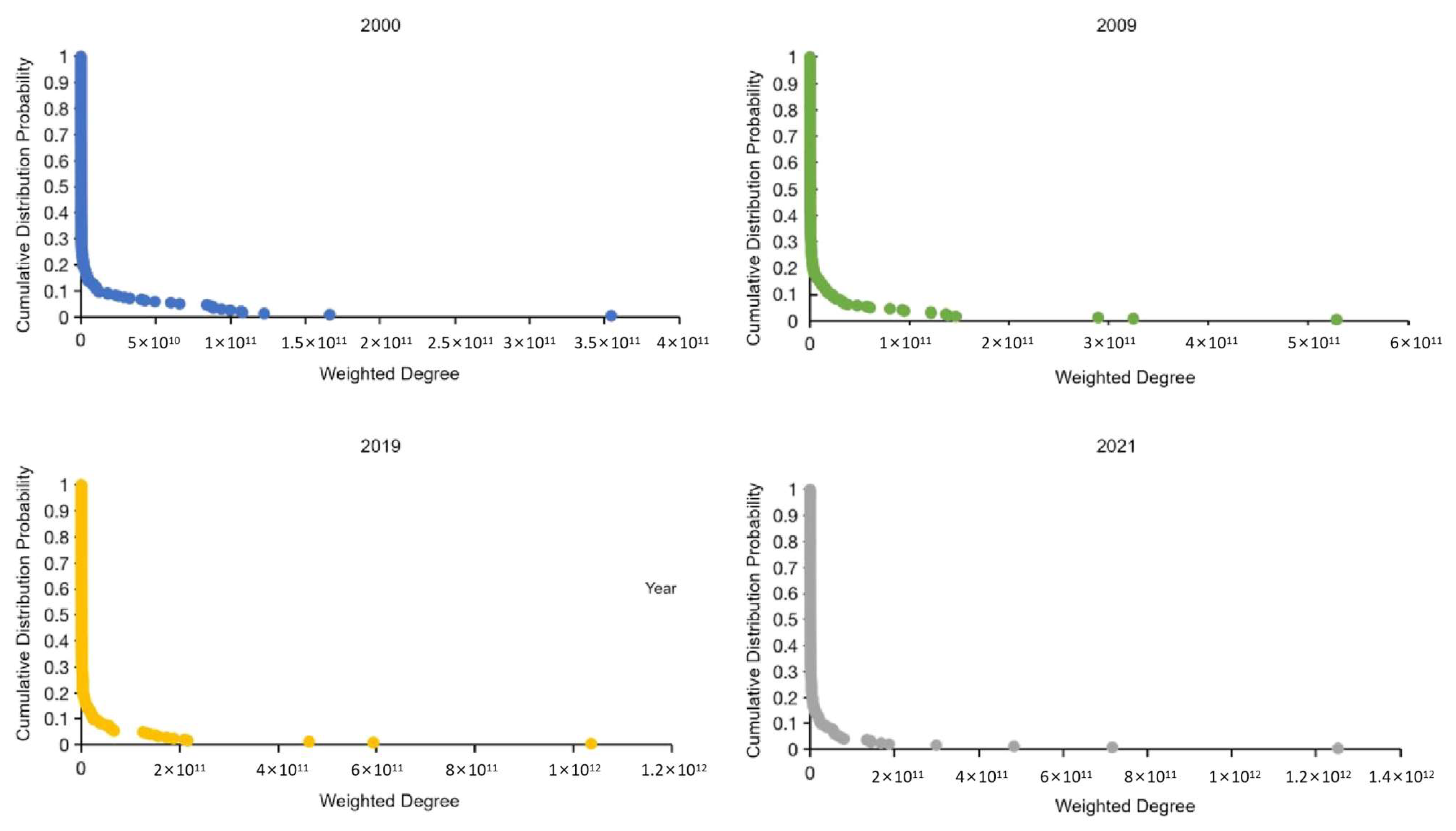
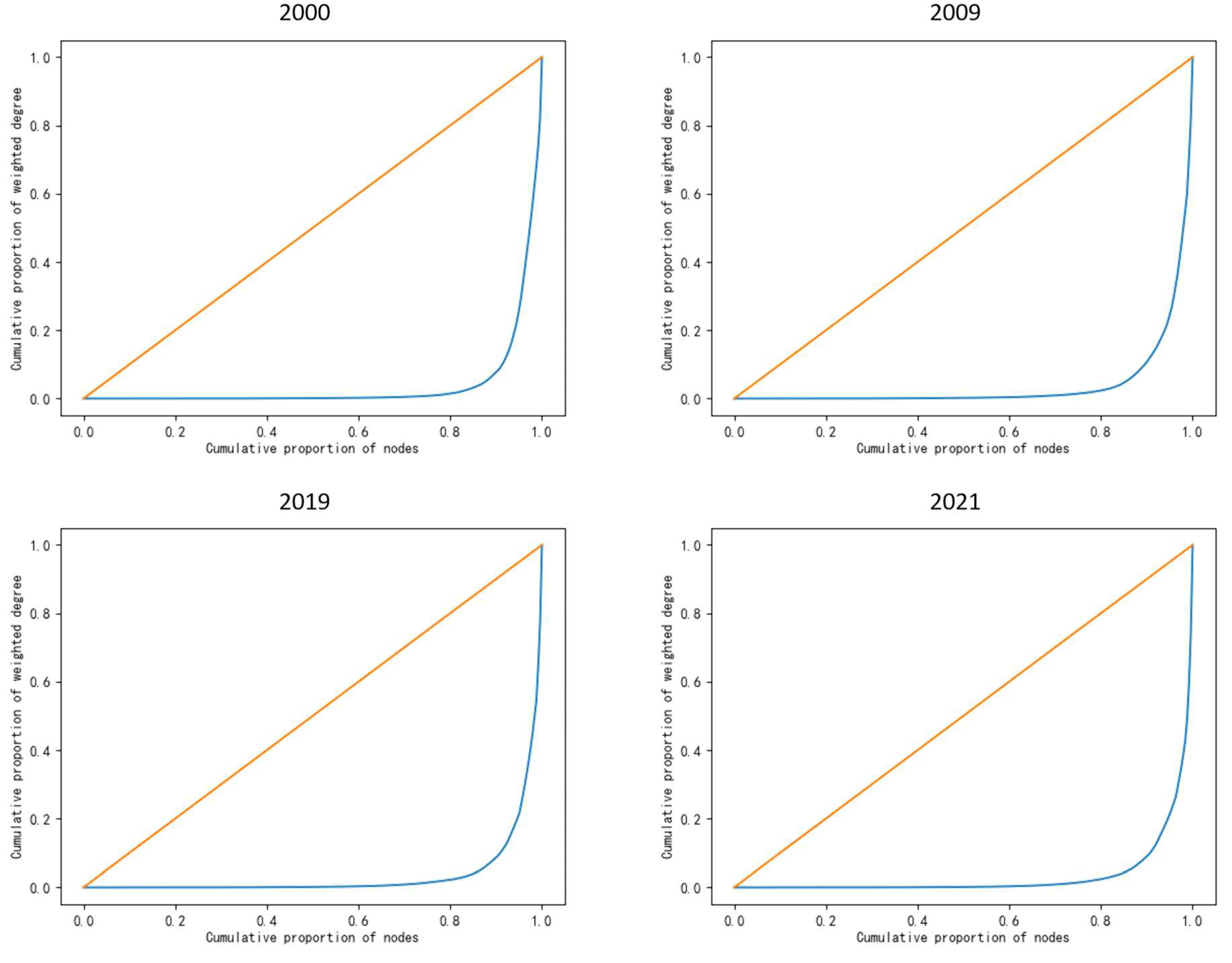
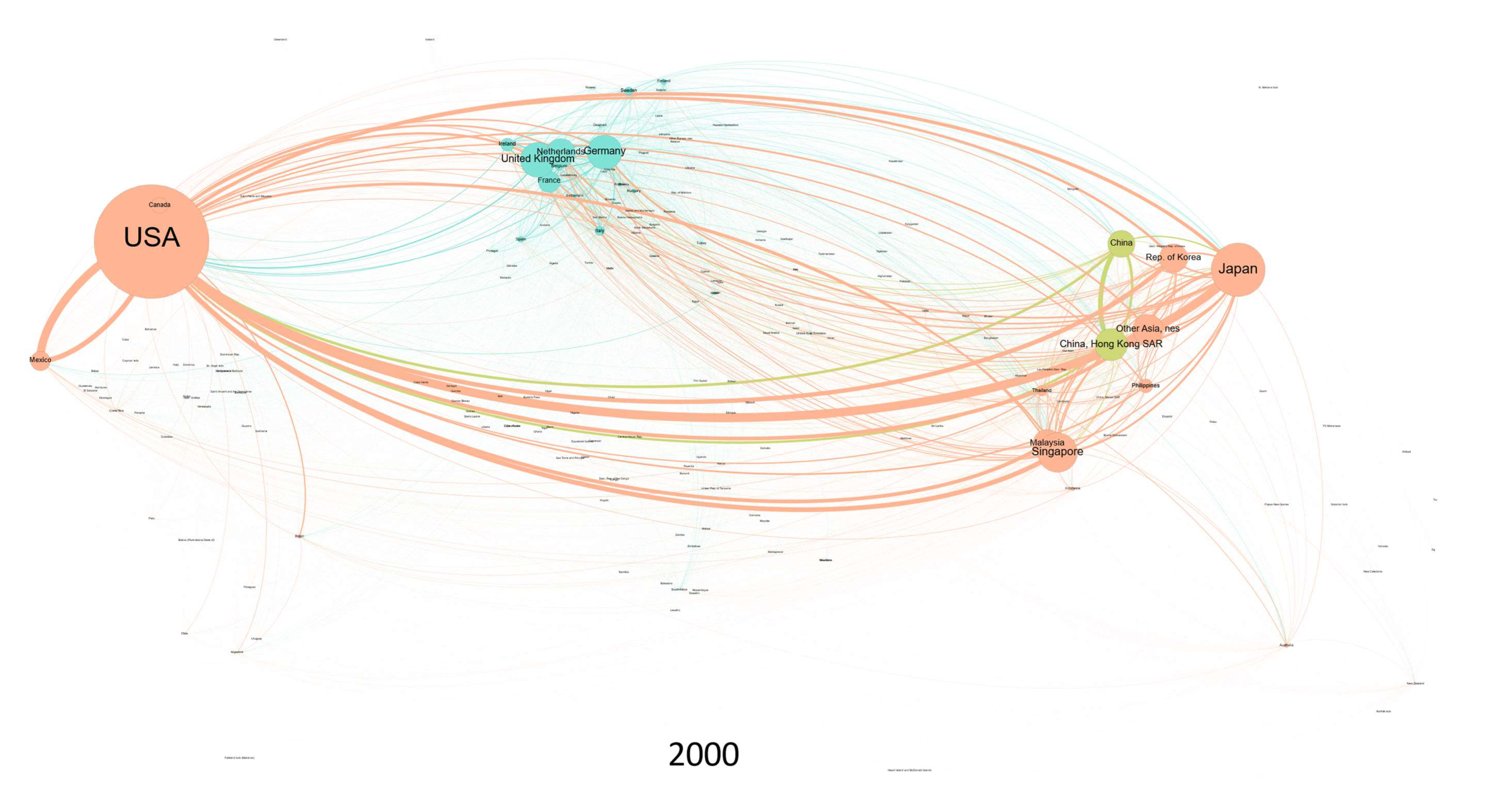
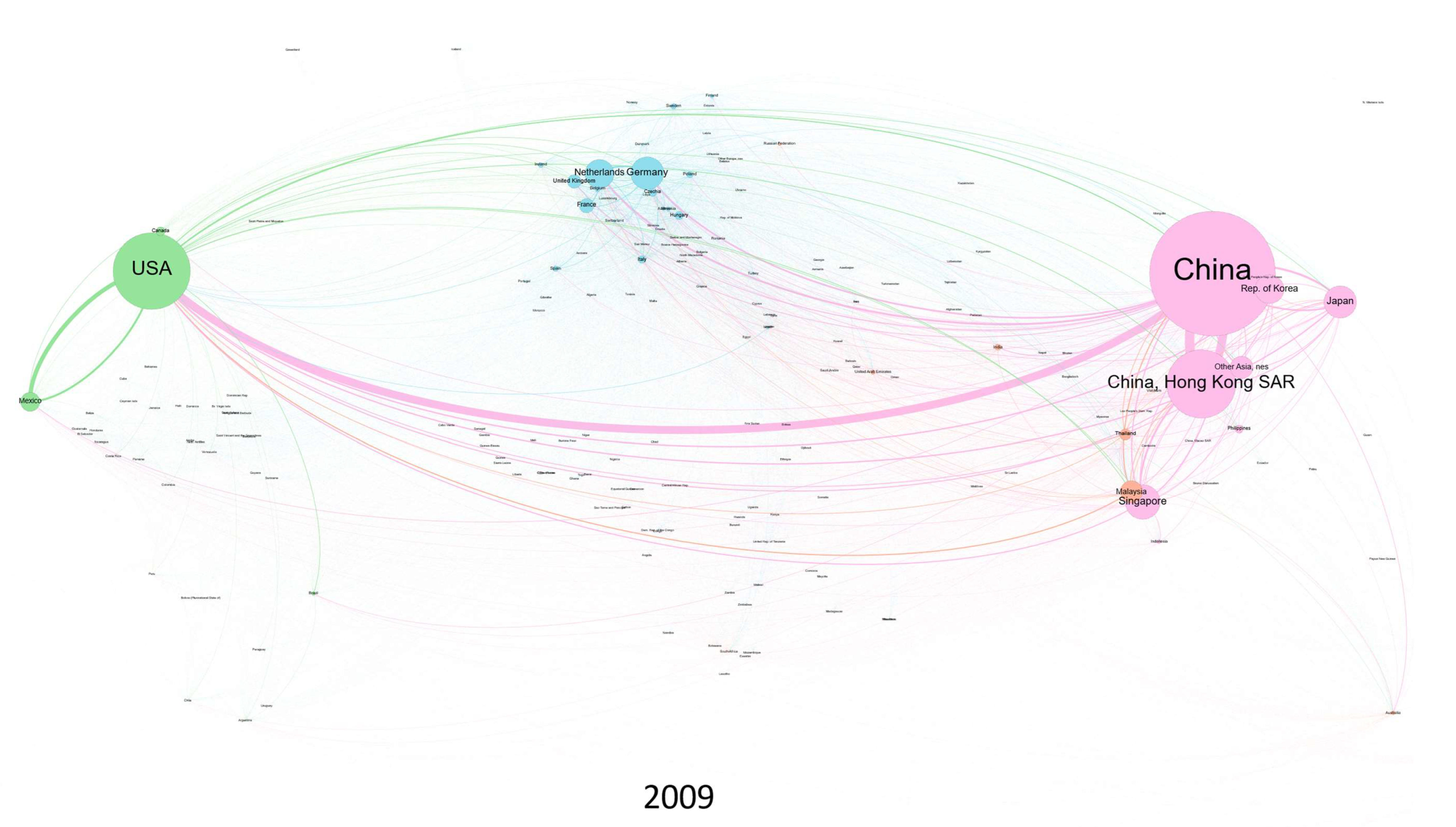
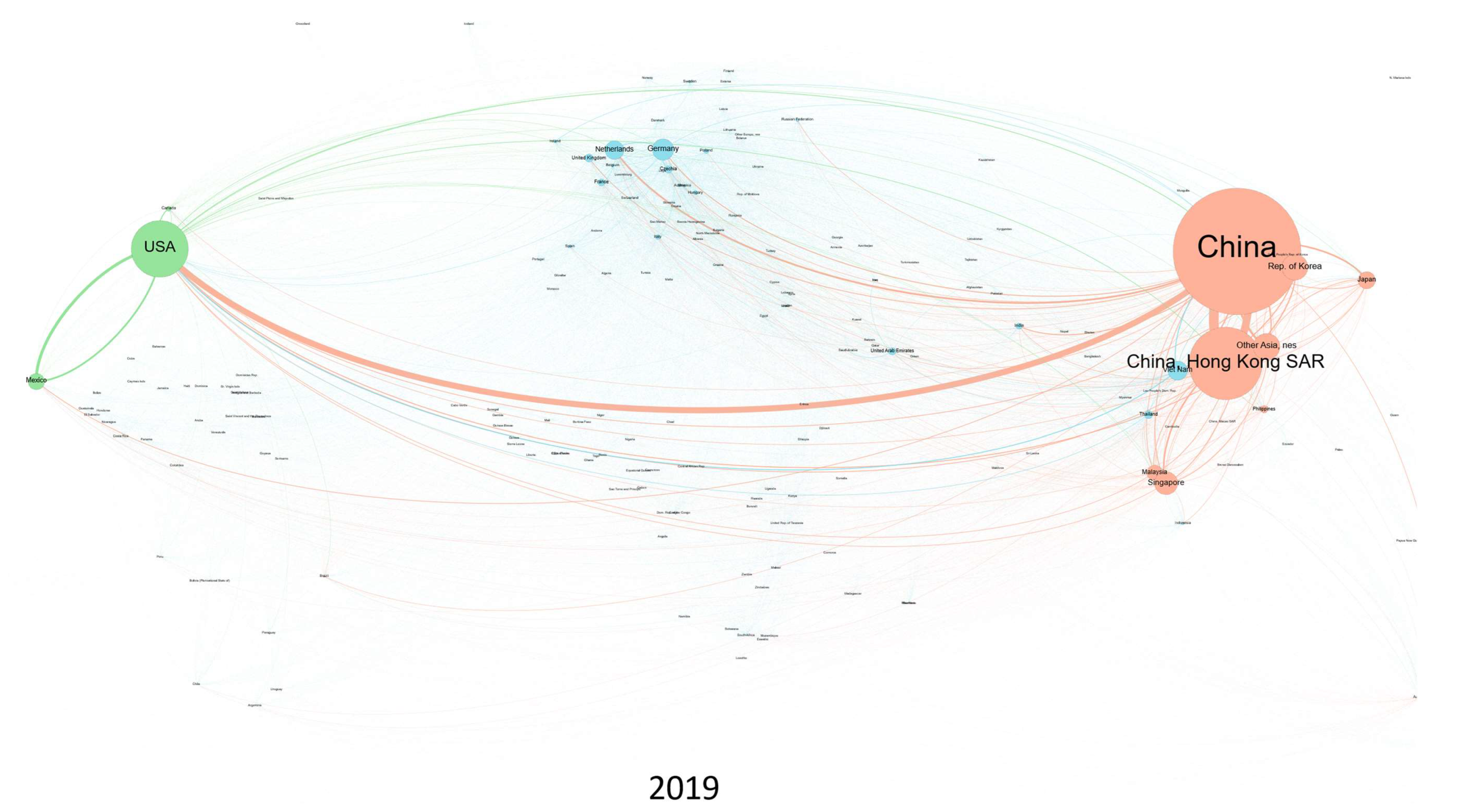
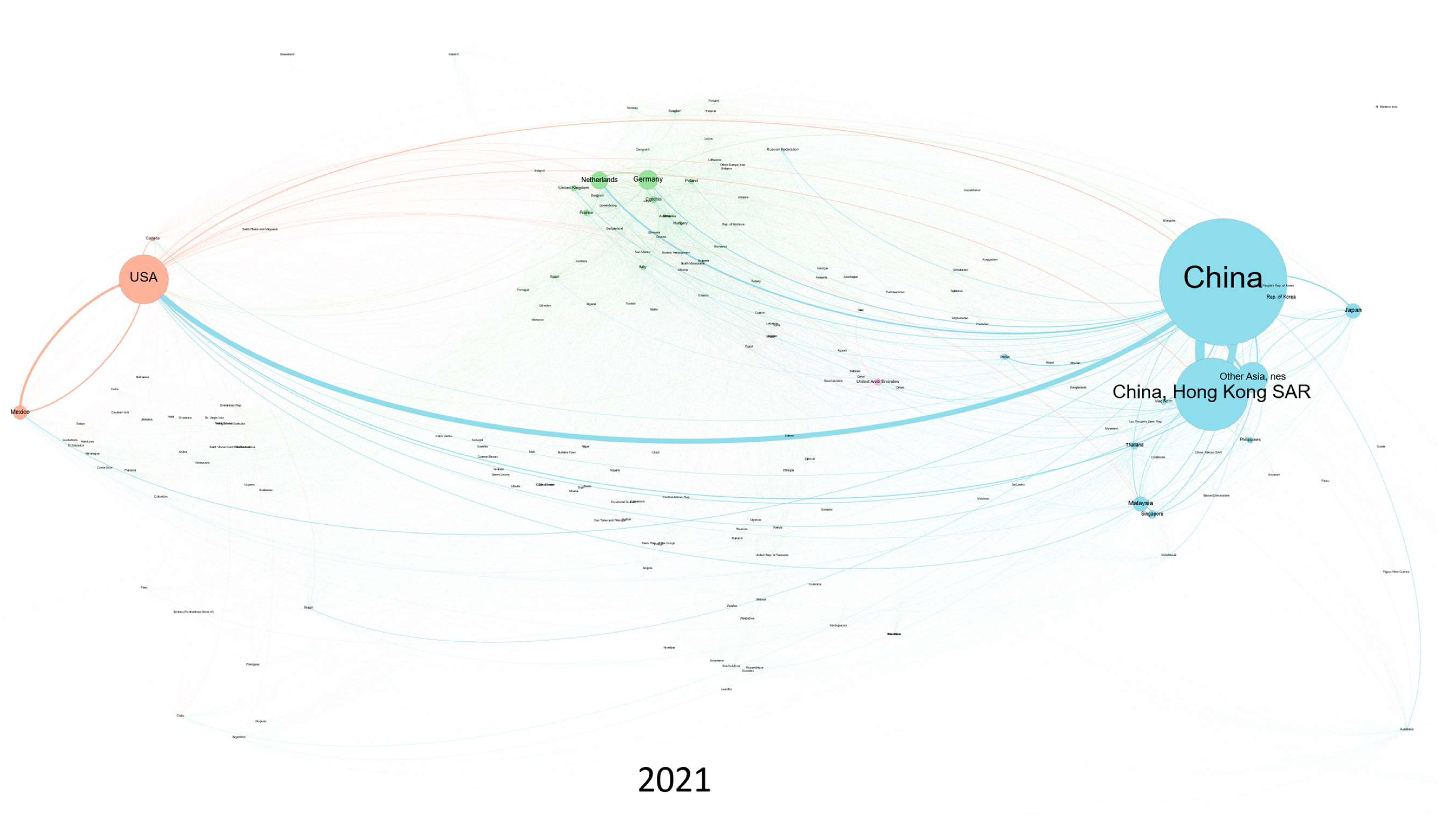
| Ranking | 2000 | 2009 | 2019 | 2021 |
|---|---|---|---|---|
| 1 | USA | CHN | CHN | CHN |
| 2 | JPN | USA | HKG | HKG |
| 3 | SGP | HKG | USA | USA |
| 4 | GBR | SGP | Other * | Other * |
| 5 | DEU | DEU | KOR | DEU |
| 6 | HKG | JPN | SGP | NLD |
| 7 | Other * | KOR | DEU | JPN |
| 8 | KOR | NLD | VNM | MYS |
| 9 | NLD | Other * | NLD | MEX |
| 10 | MYS | MYS | JPN | SGP |
| Year | Nodes | Edges | Average K | D | Average C |
|---|---|---|---|---|---|
| 2000 | 240 | 9859 | 41.079 | 0.172 | 4,126,141,547.950 |
| 2009 | 242 | 12,706 | 52.504 | 0.218 | 5,856,188,667.008 |
| 2019 | 245 | 13,571 | 55.392 | 0.227 | 9,341,450,273.698 |
| 2021 | 246 | 11,436 | 46.492 | 0.190 | 9,751,075,087.069 |
| Year | CL | L | Random Network Nodes | CL | L |
|---|---|---|---|---|---|
| 2000 | 0.720 | 1.767 | 240 | 0.026 | 2.874 |
| 2009 | 0.723 | 1.704 | 242 | 0.027 | 2.806 |
| 2019 | 0.734 | 1.655 | 245 | 0.023 | 2.824 |
| 2021 | 0.745 | 1.589 | 246 | 0.026 | 2.827 |
| Ranking | 2000 | 2009 | 2019 | 2021 | ||||
|---|---|---|---|---|---|---|---|---|
| 1 | BDI | 1 | USA | 0.916 | USA | 0.910 | DEU | 0.904 |
| 2 | ERI | 1 | DEU | 0.906 | DEU | 0.907 | GBR | 0.904 |
| 3 | USA | 0.902 | FRA | 0.899 | FRA | 0.904 | NLD | 0.897 |
| 4 | GBR | 0.888 | CHN | 0.880 | CHN | 0.897 | USA | 0.891 |
| 5 | FRA | 0.882 | GBR | 0.876 | GBR | 0.897 | CHN | 0.881 |
| 6 | DEU | 0.866 | NLD | 0.867 | NLD | 0.891 | FRA | 0.875 |
| 7 | NLD | 0.854 | Other * | 0.867 | DNK | 0.875 | ESP | 0.872 |
| 8 | ITA | 0.833 | KOR | 0.855 | BEL | 0.868 | DNK | 0.872 |
| 9 | BEL | 0.827 | CAN | 0.855 | IND | 0.862 | TUR | 0.857 |
| 10 | CHE | 0.827 | BEL | 0.849 | ESP | 0.862 | CAN | 0.854 |
| Ranking | 2000 | 2009 | 2019 | 2021 | ||||
|---|---|---|---|---|---|---|---|---|
| 1 | USA | 3425.257 | USA | 2825.946 | USA | 1682.076 | USA | 1533.264 |
| 2 | GBR | 2172.528 | FRA | 1672.460 | CHN | 1542.691 | GBR | 883.560 |
| 3 | FRA | 2124.083 | GBR | 1508.359 | GBR | 1339.005 | DEU | 799.529 |
| 4 | DEU | 1565.765 | CHN | 1363.075 | FRA | 1169.540 | NLD | 783.903 |
| 5 | CAN | 1248.684 | DEU | 1164.689 | NLD | 1113.542 | FRA | 744.225 |
| 6 | ITA | 1061.292 | NLD | 1035.971 | DEU | 1056.536 | CHN | 702.931 |
| 7 | NLD | 1057.005 | AUS | 891.280 | HKG | 863.419 | HKG | 577.019 |
| 8 | AUS | 998.388 | BEL | 798.878 | ARE | 822.815 | CAN | 557.644 |
| 9 | CHE | 958.418 | CAN | 764.569 | CAN | 767.987 | ARE | 557.445 |
| 10 | ZAF | 929.406 | DNK | 744.849 | ITA | 698.669 | BEL | 522.302 |
Disclaimer/Publisher’s Note: The statements, opinions and data contained in all publications are solely those of the individual author(s) and contributor(s) and not of MDPI and/or the editor(s). MDPI and/or the editor(s) disclaim responsibility for any injury to people or property resulting from any ideas, methods, instructions or products referred to in the content. |
© 2023 by the authors. Licensee MDPI, Basel, Switzerland. This article is an open access article distributed under the terms and conditions of the Creative Commons Attribution (CC BY) license (https://creativecommons.org/licenses/by/4.0/).
Share and Cite
Zhu, X.; Liu, X. Research on the Evolution of Global Electronics Trade Network Structure since the 21st Century from the Chinese Perspective. Sustainability 2023, 15, 5437. https://doi.org/10.3390/su15065437
Zhu X, Liu X. Research on the Evolution of Global Electronics Trade Network Structure since the 21st Century from the Chinese Perspective. Sustainability. 2023; 15(6):5437. https://doi.org/10.3390/su15065437
Chicago/Turabian StyleZhu, Xiaodong, and Xin Liu. 2023. "Research on the Evolution of Global Electronics Trade Network Structure since the 21st Century from the Chinese Perspective" Sustainability 15, no. 6: 5437. https://doi.org/10.3390/su15065437
APA StyleZhu, X., & Liu, X. (2023). Research on the Evolution of Global Electronics Trade Network Structure since the 21st Century from the Chinese Perspective. Sustainability, 15(6), 5437. https://doi.org/10.3390/su15065437






